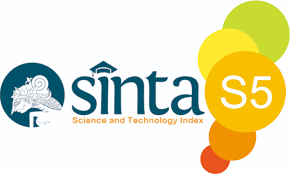Klasifikasi Kualitas Buah SawitMenggunakan Metode Gray Level Co-occurrence Matrix Dengan Variasi Arah Obyek
Abstract
The harvest of fresh fruit bunches (FFB) from palm fruit is done with fruit that is of good quality, namely fruit that is dark red in color or has lots of knots, so that the quality of the palm oil produced increases. Low quality produced will of course further weaken competitiveness. Determining the quality classification of palm oil can be done through image processing techniques. Classification is the process of declaring a data object to one of the previously defined categories. Categorization of data sets can involve grouping them into similar types of classification or identifying similar characteristics across a number of observations. Classification is supported by the concept of pattern recognition, classifying the quality of palm oil products as categories produced. Efforts to achieve the expected quality standards by using quality control. This classification of palm oil is divided into quality classes, namely good and not good. Knowing the quality of palm oil is done by making an application for palm oil quality using image processing. There are quite a lot of methods used in image processing technology. One of them is the Gray Level Co-Occurrence Matrix (GLCM) method. Gray Level Co-Occurrence Matrix (GLCM) is a method used for texture analysis/feature extraction, feature acquisition is obtained from matrix pixel values, which have certain values and form an angle pattern. Palm Fruit Quality Classification Using Gray Level Co-occurrence Matrix With Variations in Object Direction. It is hoped that this application can help determine the quality of palm fruit more easily and efficiently.
Downloads
References
[2] Apriyansyah (2016) ‘Identifikasi hama serangga pada tanaman kelapa sawit’, p. 150.
[3] Wijaya Ardi, Franata, Heru (2020) ‘Peningkatan Hasil Segmentasi Deteksi Tepi Menggunakan Morphology Pada Pengolahan Citra’.
[4] ELVIRA, D. (2016) YAYASAN LEMBAGA PENDIDIKAN ISLAM DAERAH RIAU UNIVERSITAS ISLAM RIAU FAKULTAS TEKNIK Klasifikasi Citra Daun Kelapa Sawit Yang Terkena Dampak Hama Menggunakan Metode K-Nearest Neighbor (KNN) Laporan Skripsi.
[5] Harahap, L.A. et al. (2018) ‘Identifikasi Penyakit Daun Tanaman Kelapa Sawit dengan Teknologi Image Processing Menggunakan Aplikasi Support Vector Machine’, Talenta Conference Series: Agricultural and Natural Resources (ANR), 1(1), pp. 53–59. doi:10.32734/anr.v1i1.96.
[6] Ardi wijaya, Puji Rahayu, Rozali Toyib (2021) ‘Analisis Algoritma Shi-Tomasi Dalam Pengujian Citra Senyum Pada Wajah Manusia’.
[7] HttpHttps://bakri.uma.ac.id/mengenal-kelapa-sawit/. (2022). Mengenal Kelapa Sawit.s://bakri.uma.ac.id/mengenal-kelapa-sawit/ (2022) Mengenal Kelapa Sawit.
[8] Https://glints.com/id/lowongan/matlab-adalah/#apa-itu-matlab (2021) MATLAB, Platform Pemrograman dengan Segudang Kegunaan.
[9] Lusiana, V. et al. (2019) EKSTRAKSI FITUR TEKSTUR MENGGUNAKAN MATRIKS GLCM PADA CITRA DENGAN VARIASI ARAH OBYEK.
[10] Mukrimaa, S.S. et al. (2016) ‘pengolahan citra’, Jurnal Penelitian Pendidikan Guru Sekolah Dasar, 6(August), p. 128.
[11] Sari, L. and Sari siregar, G. yanti kemala (2021) ‘Perancangan Aplikasi Pendataan Data Kepegawaian Negeri Sipil Pada Dinas Komunikasi Dan Informatika Kota Metro’, Jurnal Mahasiswa Ilmu Komputer, 2(1), pp. 115–135. doi:10.24127/.v2i1.1235.
[12] Shandy, Q., Panna, S.S. and Malago, Y. (2019) ‘Penerapan Metode Grey Level Co-Occurrence Matriks (GLCM) dan K-Nearest Neighbor (K-NN) Untuk Mendeteksi Tingkat Kualitas baik Buah Belimbing Bintang’, Jurnal Nasional cosPhi, 3(1), pp. 2597–9329.
[13] Widodo, R. et al. (2018) Pemanfaatan Ciri Gray Level Co-Occurrence Matrix (GLCM) Citra Buah Jeruk Keprok (Citrus reticulata Blanco) untuk Klasifikasi Mutu. Available at: http://j-ptiik.ub.ac.id.
Copyright (c) 2024 Ridho Ikhlasul; Ardi Wijaya, Nuri David Maria Veronica, Rozali Toyib

This work is licensed under a Creative Commons Attribution-ShareAlike 4.0 International License.
An author who publishes in Jurnal Media Infotama agrees to the following terms:The author holds the copyright and grants the journal the right of first publication of the work simultaneously licensed under the Creative Commons Attribution-Share Alike 4.0 License which allows others to share the work with acknowledgment of the work's authorship and initial publication in this journal.Submission of a manuscript implies that the submitted work has not been previously published (except as part of a thesis or report, or abstract); that it is not being considered for publication elsewhere; that its publication has been approved by all co-authors. If and when a manuscript is accepted for publication, the author retains the copyright and retains the publishing rights without limitation.
For new inventions, authors are advised to administer the patent before publication. The license type is CC-BY-SA 4.0.
MEDIA INFORMATION REVIEW: Journal of the Faculty of Computer Science is licensed under a Creative Commons Attribution-ShareAlike 4.0 International License.You are free to:Share
— copy and redistribute material in any medium or formatAdapt
— remix, modify and develop materialfor any purpose, even commercial.
The licensor cannot revoke this freedom as long as you follow the license terms












.png)


